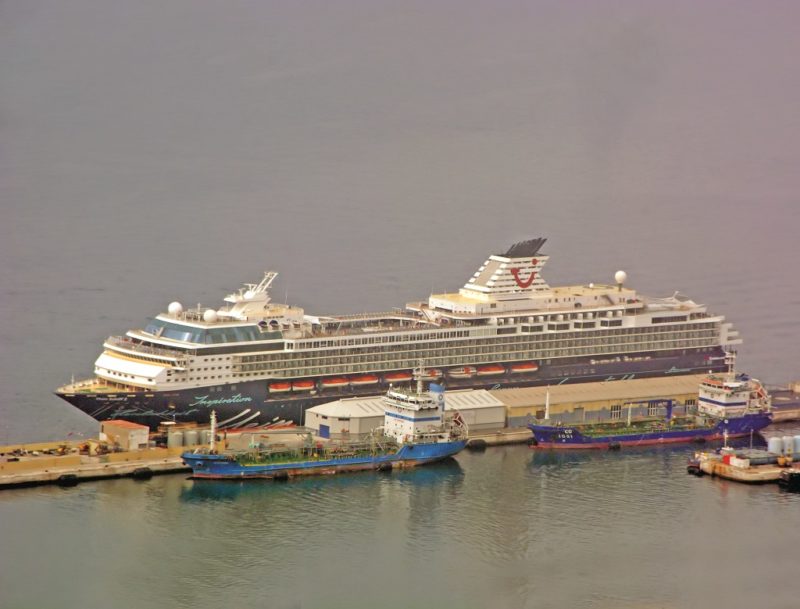
Gibraltar is of great strategic importance, providing bunkering, repair facilities and shelter to ships as well as a valuable airport for tourism. The narrow rocky limestone peninsula of Gibraltar is joined to the mainland by a low, flat sandy isthmus, which is crossed by a neutral zone and the Spanish frontier. Relations between Britain and Spain over the question of the sovereignty of Gibraltar are far from peaceful and friendly, with frequent testing on a daily basis of British Gibraltar Territorial Waters (BGTW) and air space taking place by Spanish military helicopters or launches. The Rock has permanent ownership in perpetuity of the eastern half of Gibraltar Bay with excellent anchorages and a fine harbour enclosed by three breakwaters.
The climate is always warm and sunny with January temperatures averaging 17 degrees Centigrade, rising to 30 degrees in summer. Summers are virtually rainless, with many types of vegetation and wild olives to be seen. Seawater distillation plants supplement the meagre water supply, and Gibraltar has no agriculture or mineral deposits of any type, with fresh vegetables brought in daily from Spain. Import duties are low, with the primary economic source being the bunkering of fuel oil, diesel oil and LNG of over five million tonnes per year to many thousands of ships.
The second source of income is the arrival of over 400,000 cruise passengers per year, and over eleven million international passengers arriving by foot, car, coach or aeroplane.
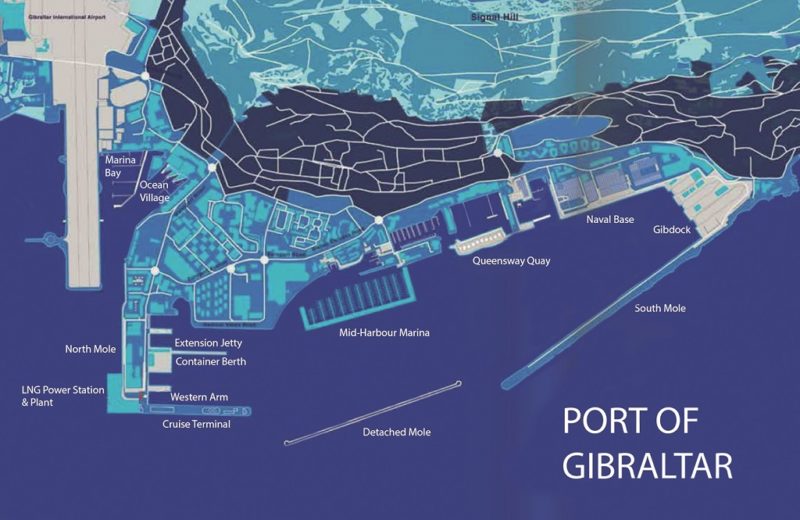
HISTORY OF GIBRALTAR
The Mediterranean Sea was formed when the Atlantic Ocean breached a line of very high ground that reached southwards from the Rock of Gibraltar (Gibel al Tariq in Arabic), now of height 1,400 feet, to the mountain of Gibel Musa in North Morocco and now of height 2,700 feet. These mountains were known as the ‘Twin Pillars of Hercules’ by the hero who later became a god, Heracles of Greece. The Neanderthal species of man as well as early Homo Sapiens lived in Gorham’s Caves and other caves on the east side of Gibraltar, these caves were in continuous occupation during a period that lasted from 40,000 years ago to 5,000 years ago. There are still animal bones, stone tools and ancient hearths to be seen or are dug up in these caves today. Broken ceramic pots typical of these early cultures and also found on Mainland Spain around Almeria have been found in Gorham’s Cave. However, there was no evidence of habitation in the Bronze Age as people had largely stopped living in caves by then.
During ancient times, Gibraltar was regarded by the peoples of the Mediterranean as a place of religious and symbolic importance. The Phoenicians were present for several centuries from around 950 BC, with Gorham’s Cave used as a shrine, as were the original Carthaginians and Romans after them. Gibraltar was known as Mons Calpe, a name perhaps of Carthaginian origin. These peoples settled in North Gibraltar in the Campo flat area where the airport is today. The town of Carteia, near the modern Spanish town of San Roque, was founded by the Phoenicians around 950 BC on the site of an early settlement of the native Turdetani people. The Spanish town of La Linea is directly opposite Gibraltar with its busy road crossing between the two countries.
After the collapse of the Western Roman Empire, Gibraltar became briefly under the control of the Vandals, who crossed into Africa at the invitation of Boniface, the commander of the territory. This area later formed part of the Visigothic Kingdom of Hispania for almost 300 years from 414 to 711 AD. A predominantly Berber army from North Africa under the command of Tariq ibn Ziyad crossed to Gibraltar in April 711, and this led to the Islamic conquest of most of the Iberian Peninsula. Gibel al Tariq subsequently became corrupted into the modern name of Gibraltar. In 1160, the Almohad Sultan Abd al Mu’min ordered that a permanent settlement, including a castle, be built. It received the name of Medinat al Fath (City of the Victory). The Tower of Homage of the Moorish Castle remains standing today. At Europa Point, the southernmost point of The Rock, near to the red and white striped lighthouse, there is also a modern Islamic church with a tall thin white tower.
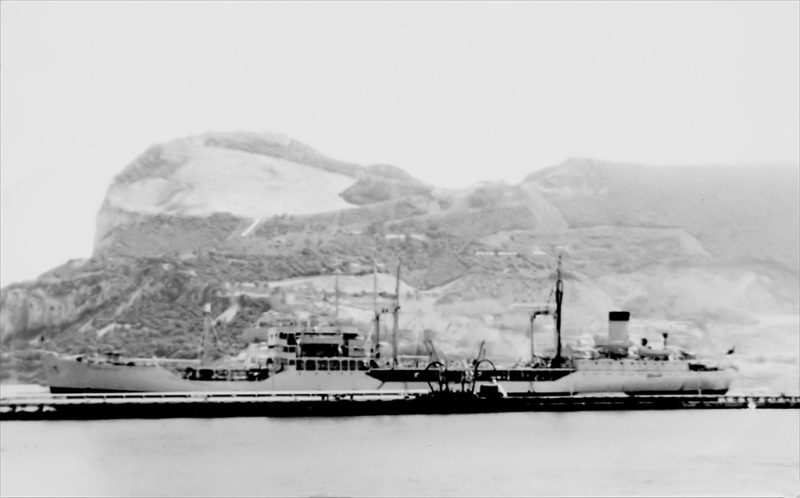
Gibraltar was fought over and captured by the Nasrids in 1237 and 1374, the Marinids of Morocco in 1274 and 1333, and the Kings of Castile in Northern Spain in 1309. In 1462, Gibraltar was captured by Juan Alonso de Guzman, 1st Duke of Medina Sidonia, from the Emirate of Granada. There is a statue of ‘Guzman the Good’ in the port of Tarifa near to where one takes the fast craft crossing of the Straits of Gibraltar to Tangier. After the conquest, Henry IV of Castile assumed the additional title of King of Gibraltar, establishing it as a part of the ‘Comarca’ of the Campo Llano de Gibraltar. Six years later, Gibraltar was restored to the Duke of Medina Sidonia, who sold it in 1474 to a group of ‘Conversos’, or Christian converts from Judaism, from Cordoba and Seville. This was in exchange for maintaining the garrison of the town for two years, after which time they were expelled, returning to their home towns and moving to other parts of Spain. In 1492, Boabdil, the last Muslim leader of Granada, handed the keys of the city over to troops of Ferdinand and Isabella of Castile without a fight, and moved down the steep road to Motril, a modern sugar port today, and to exile in North Africa. In 1501, Gibraltar passed back to the Spanish Crown and Isabella I of Castile issued a Royal Warrant granting Gibraltar the Coat of Arms that it still uses today.
On 17th July 1704, during the War of the Spanish Succession, a council of war was held aboard the English warship Royal Catherine off the North African town of Tetuan, and later that day 1,300 English and Dutch marines were landed on the isthmus with the Dutch Prince Hesse at the head. Gibraltar was encircled and cut off but the Governor of Gibraltar refused to surrender. The days that followed saw a massive bombardment of the town by the English warships of the combined Anglo-Dutch fleet representing the Grand Alliance between the two countries. Finally on 23rd July, a fusillade of 1,500 cannon balls were fired in five to six hours with landings in the south, and the Governor capitulated, and the Anglo-Dutch force captured the town of Gibraltar on behalf of Archduke Charles of Austria in his campaign to become King of Spain. Most of the local population left the town, with many settling nearby in La Linea. As the campaign of the Grand Alliance began to falter, the Treaty of Utrecht of 1713 was negotiated, which gave control of Gibraltar in perpetuity to the U.K. in order to secure the withdrawal of the U.K. from the war. The Rock remains very much British today, with the population wishing to remain 100% British during recent referenda.
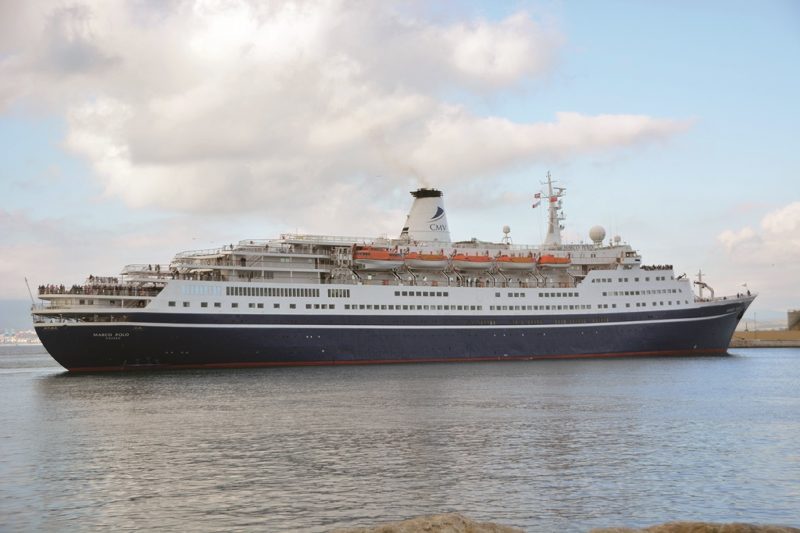
MODERN HISTORY OF THE PORT
British Gibraltar was an important naval base during the Napoleonic Wars and during World War II. The Straits of Gibraltar are only 8.9 miles wide at the narrowest point between Tarifa and North Africa. There are two shipping lanes, one into the Mediterranean, and the other out of the Mediterranean, with sea water moving fast at the surface and over the seabed in opposite directions. German U-boats used this phenomenon to good effect when running the blockade of the Straits by British destroyers and frigates equipped with sonar and depth charges.
The Battle of Trafalgar on 21st October 1805 saw British warships under Admiral Lord Horatio Nelson meet a strong combined Spanish and French fleet under French Admiral Villeneuve, and by an audacious ‘Crossing the T’ attack by Admiral Lord Horatio Nelson directly at right angles to the enemy line, the battle was convincingly won. Twenty enemy ships were lost and no British warships. Unfortunately, Nelson was badly wounded by a sniper bullet on his flagship Victory, and his body and his badly damaged flagship were towed back to Gibraltar by HMS Neptune, arrived on 28th October 1805. In Nelson’s Anchorage near Rosia Bay his body was placed in a barrel of wine to prevent de-composure and taken by sea for a national victory parade in London. The 200th Anniversary of the Battle of Trafalgar was celebrated in Gibraltar on 21st October 2005.
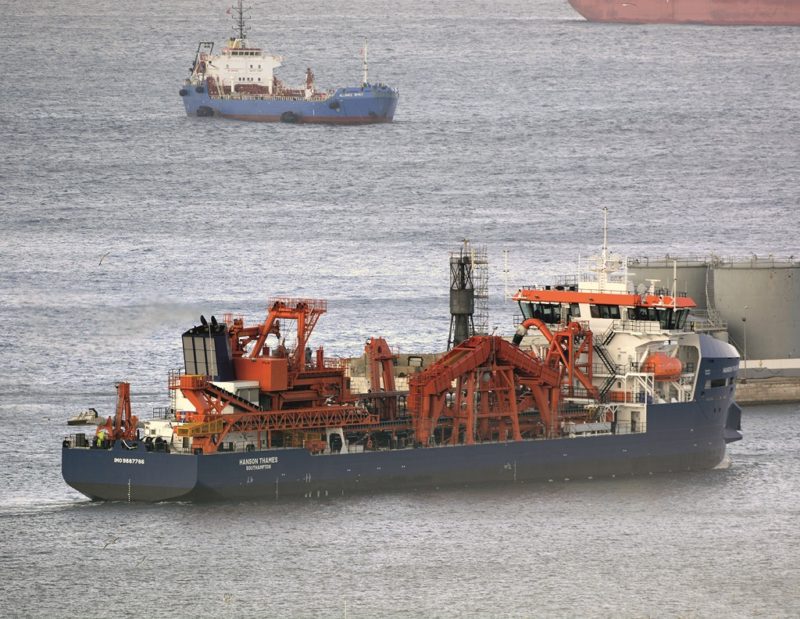
In 1830, Gibraltar became a British Crown Colony, and H. M. Gibraltar Dockyard was built from this date, with the three dry-docks dating from1891 to 1906. During the course of the 19th century, Gibraltar developed into a formidable fortress with tunnels cut across the base of the mountain to store food and ammunition and thus able to hold out indefinitely when besieged. This impregnability coined the phrase ‘As safe as the Rock of Gibraltar’ in common parlance.
The harbour we see today is almost enclosed by a trio of breakwaters, with construction of the original South Mole begun in 1713 together with its protective batteries of guns stretching round from Rosia Bay a century later. This mole had been greatly expanded by Victorian times to 650 metres or 2,000 feet, but it was not until 1895 that plans were made for a Detached Mole with a battery of guns and a North Mole. The 1895 Harbour Plan was to enclose Gibraltar to the west by extending further the South Mole and constructing a Detached Mole, with the enclosure of the north end of the harbour undecided and a matter of some controversy. The 1895 Gibraltar Naval Works Loan Act provided the necessary finance to construct this ambitious scheme to provide a modern defensive harbour, safe from torpedo attack, and the initial works were largely completed by 1902. Britain provided almost all of the capital, with a small contribution by the Government of Gibraltar.
The North Mole is a later construction and is an ‘L’ shaped breakwater and a Western Arm of length 1,600 feet that runs down almost to the Detached Mole of length 2,400 feet. This is the commercial port of today with a total length of 7,500 feet of quay for cruise ships, cargo handling and bunkering. Some fifteen berths are available with six on the Western Arm and two on the extension jetty.
The south end of Western Arm is the site of Gibraltar North Mole Lighthouse, a cast iron structure with a black, octagonal latticework tower and a quick flashing red light with a range of five nautical miles. Cables stretch underwater from the North Mole to the Detached Mole, and from the South Mole to the Detached Mole, with foghorns at the head of each mole, and with also a traffic light system of green and red lights for entry and departure from the gaps. There is a large prohibited anchorage at the western end of the aircraft runway. The North Mole has an alongside depth of 9.1 metres at any time or state of the tide with minimum depths ranging from 8.2 metres to 9.7 metres.
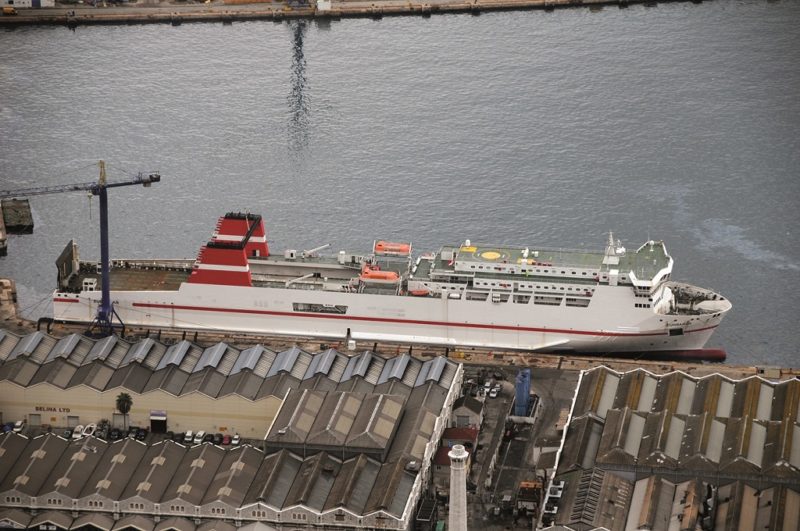
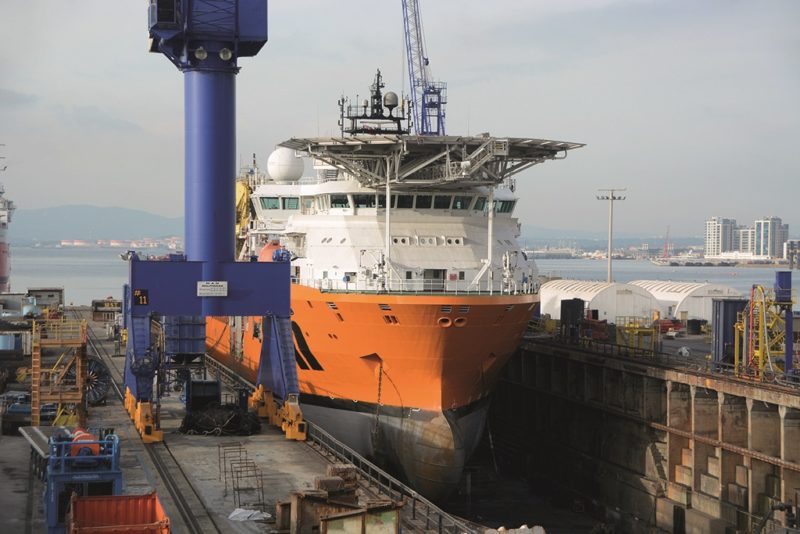
GIBRALTAR PORT AUTHORITY
Gibraltar Port Authority was established in 2005 to regulate the flow of vessels visiting the port as to their safe navigation, bunkering and passenger and cargo handling. The remit covers the following functions:-
- Monitoring and control of all vessel movements in British Gibraltar Territorial Waters (BGTW) in support of port operations and navigational safety.
- Provision and monitoring of port security with security controls within restricted and controlled zones.
- Licensing of port operations.
- Search and rescue in BGTW.
- Pollution prevention and response.
- Monitoring and control of all bunkering and ship-to-shore operations.
Berth Length(m) Depth(m)
1W-2W-3W 490 9.6
Western Arm Outside Cruise Berth, pneumatic fendering is provided afloat, with a long transit shed of 2,100 m2 converted into the cruise terminal, with water, and the oil bunkering facilities.
1E-2E-3E 450 8.6 Western Arm Inside Cruise Berth
Berth 4 99 7.9 Pilots
Berth 5 99 7.9
Container berth with cranage provided up to 40 tonnes by eleven mobile cranes, and a fixed ro-ro ramp for bow or stern loading. Three water boats and a small lubricating lighter are provided. Fuel oil, diesel oil and marine fuel of any viscosity can be provided at a rate of 300 tonnes per hour, depending on grade. Fresh water, garbage disposal and medical facilities are provided.
Berth 6 99 7.9 Container berth as at Berth 5
Berth 7 245 11.0 Extension Jetty
Berth 8 245 11.0 Extension Jetty
Berth 9 99 7.9 Resolve Marine Services/Gibunco
Berth 10 99 7.9
Coaling Island berth to the north of the Gun Wharf and Ordinance Wharf in the middle of the shoreside of the harbour, and was the discharge wharf for coal, and later for two former warships used for training purposes in HMS Hart, HMS Cormorant and the coaling hulk Java. The latter ship had been built in Calcutta in 1811 and served as a coaling hulk at Gibraltar from 1857 to 1939, when she was towed to Genoa for breaking up. HMS Cormorant was launched at Chatham Dockyard in 1877 and served for 22 years on the Pacific station until she was dismantled down to her hull. She was recommissioned as a Base Ship at Gibraltar in 1894 and served for 55 years until she was disposed of in 1949. HMS Hart was launched at Devonport in 1883 and after a naval career of 20 years, she arrived at Gibraltar in 1903 as an accommodation hulk for dockyard workers, and became a coaling hulk in 1912 until she was sunk as a target ship off Gibraltar in 1948. The white hulled sister ship of HMS Cormorant is currently preserved at Chatham Dockyard as HMS Gannet.
Berth 11 99 7.9 Coaling Island berth as in Berth 10
Berth 12 99 7.9 Coaling Island berth as in Berth 10
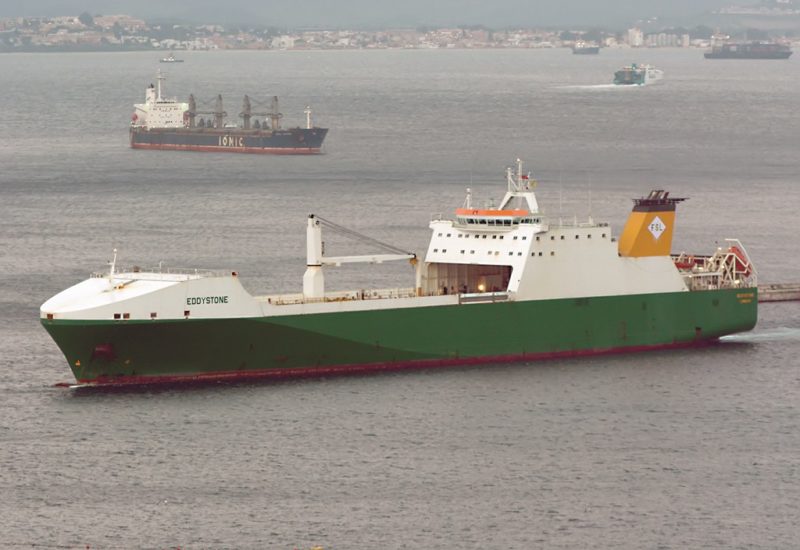
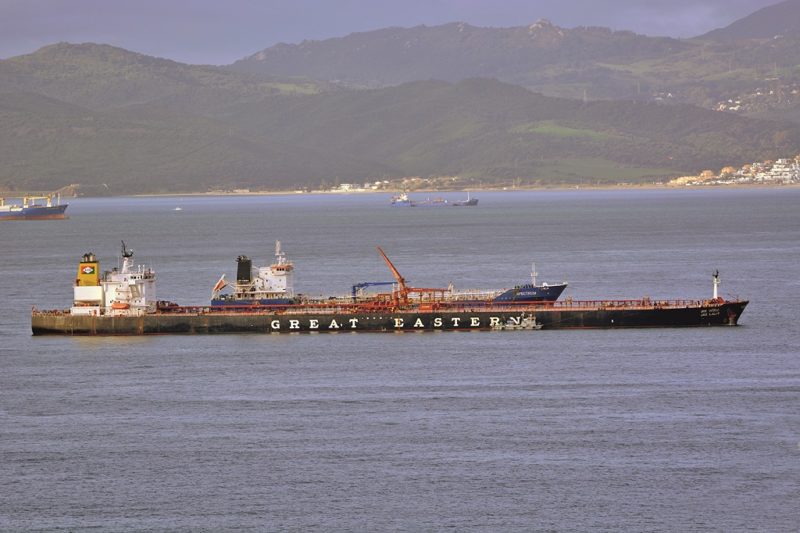
A modern salvage tug has always been stationed at Gibraltar for casualties among the 90,000 vessels transitting the Straits of Gibraltar. Documents required on arrival by ships include the passenger list and crew list in triplicate, and lists of stores, tobacco and spirits. Certificates of de-ratting, health, load line, safety equipment, tonnages, nationality, insurances, oil pollution liability and cargo documents are also required together with reports of any stowaways. The Port Captain is in overall charge of the Commercial Port, while the repair yard is leased out and under commercial management. Seafarers welfare is catered for at the Mediterranean Mission to Seafarers Centre, Flying Angel Club, North Mole.
H.M. Dockyard until it was privatised in 1985 as GibDock, covered a large area of the south end of the harbour, with an original square stone headquarters building having red roof tiles, a tall square tower with a partly open upper part topped by a very tall flagpole for signals to be hoisted on the approach of severe storms. The three dry-docks are equipped with electric cranes of up to 50 tonnes lifting capacity. There are a very large number of covered workshops, and a tower at the forward end of Number 2 dry-dock, and Number 1 dry-dock can take ships up to 265 metres in length, 38 metres in beam, and 10.6 metres in depth. Powerful tugs are provided for guidance of ships at their entry and departure movements from the dry docks. Cammell, Laird had the leasing contract when I visited the port.

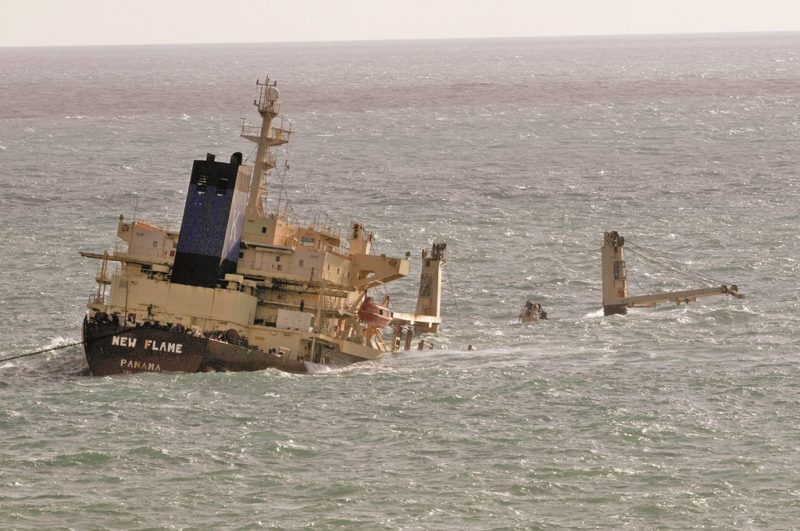
Gibraltar International Airport doubles as a Royal Air Force military aerodrome and as a civilian airport with daily flights to London, which must not fly over Spanish territory on take-off, and normally head south down the length of The Rock before turning east from Europa Point. The runway intersects Winston Churchill Avenue, the main north to south street that is required to close after movable barricades are in place when aircraft land or depart. Queues of cars build up rapidly at the international check points after extensive passport checks and opening of car boots to see if contraband is being carried, the Spanish checks at the La Linea end are much longer than the British checks.
Relations between Gibraltar and Spain are far from cordial, with the border closed completely for over sixteen years from 1969 to the end of 1985. No communication was allowed by Franco between the two countries, and thus many people travelling to work either on Gibraltar from La Linea or to La Linea from Gibraltar had to find new jobs and methods of earning a living. Gibraltar left the European Union on 31st January 2020 in line with the U.K. date of leaving, and the population of 34,000 Gibraltarians now have to suffer very much increased form filling if they want to export their goods to and from the European Union. The people of Gibraltar cling to the British systems with great pride, including driving on the right side of the road, red Victorian post boxes of the standard 1887 cylindrical design, and British style police uniforms.
The Royal Gibraltar Regiment was formed in 1958, but Gibraltar soldiers served in the Gibraltar Volunteer Corps and Gibraltar Defence Force (GDF) during two World Wars. The Regiment trains annually in the U.K. and Morocco and its soldiers have served in every major British operation since 1991 in the Gulf Wars, the Balkans, Northern Ireland, Sierra Leone, Iraq and Afghanistan. It is part of the British Army if both are required to fight together. The Gibraltar Royal Naval Air Station and its great record of flying many sorties of seaplanes and fighter planes during two World Wars is a source of great pride, and the Ceremony of the Keys in Casemates Square is a major annual public event to symbolise British permanent occupation of The Rock.
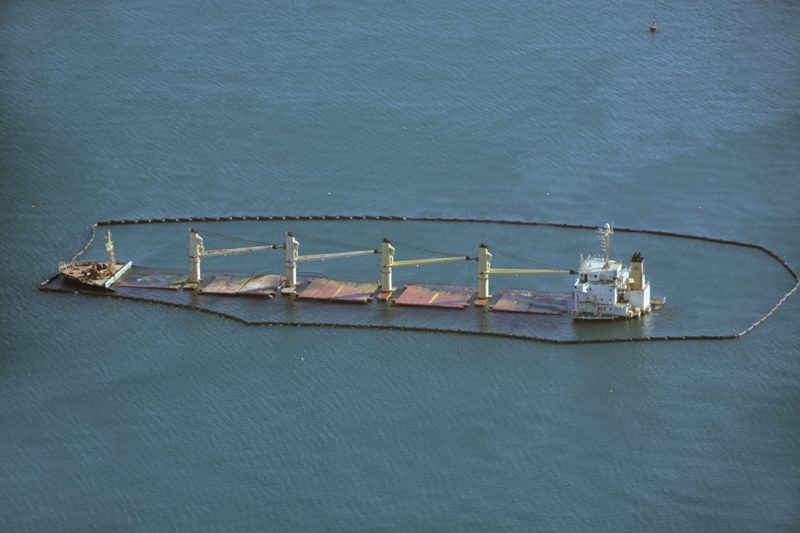
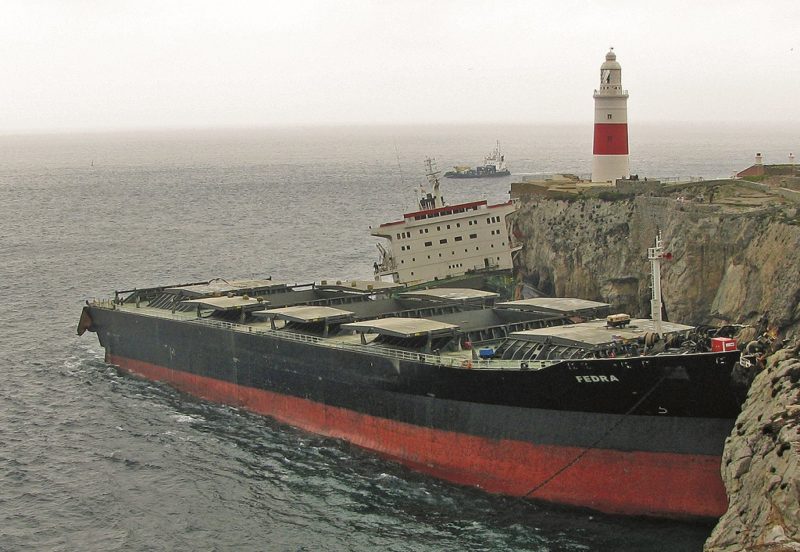
An FRS ferry links on a fortnightly basis Gibraltar with Tangier, sailing from Gibraltar at 1830 hours on Friday, and arriving back at 2000 hours on Sunday. The ferry from Gibraltar to Algeciras had been completely halted in 1969 by the failure of all Spanish and British relationships, but was reopened on 16th December 2009 served by the Spanish company Transcoma. A vehicle ramp at the west end of the North Mole allows vehicles to be unloaded from a ro-ro ferry.
The bunkering of many thousands of ships per year by an armada of around twenty small bunkering craft is big business for Gibraltar, with 5.4 million tonnes of bunkers supplied in 2006 and 5.64 million tonnes supplied in 2007. There is thus a very much increased risk of collision in the Bay of Gibraltar between ships moving to or stationary at the bunkering anchorages, fast Maersk Line container ships moving up and down the bay at 26 knots to Algeciras Container Terminal, and heavily laden oil tankers moving up the bay to Algeciras Oil Terminal. Permission to move in the Bay of Gibraltar and lane separations must be sought from Gibraltar Port Authority on their side of the bay, or from Algeciras Port Authority on their side of the bay, with the two port authorities at Gibraltar and Algeciras meeting regularly to improve safety. However, collisions and incursions of Spanish warships into British anchorages or port space occur frequently. Gibraltar Port Authority have operated a comprehensive Vessel Traffic System (VTS) since 2011 from a new, state of the art building. It operates on a 24/7 basis, co-ordinating all movements both within and outside British Gibraltar Territorial Waters (BGTW). The Port of Gibraltar is situated at position 36°8′ North, 5°21′ West, and the Government is a devolved democratic parliamentary dependency under a constitutional monarch, with a Governor, Chief Minister and Mayor of Gibraltar. Gibraltarians have a very good standard of living with an annual per capita income of £50,940 and a GDP of £1.64 billion per year, making it the third richest territory in the world. The Gibraltar pound is of course the official currency.
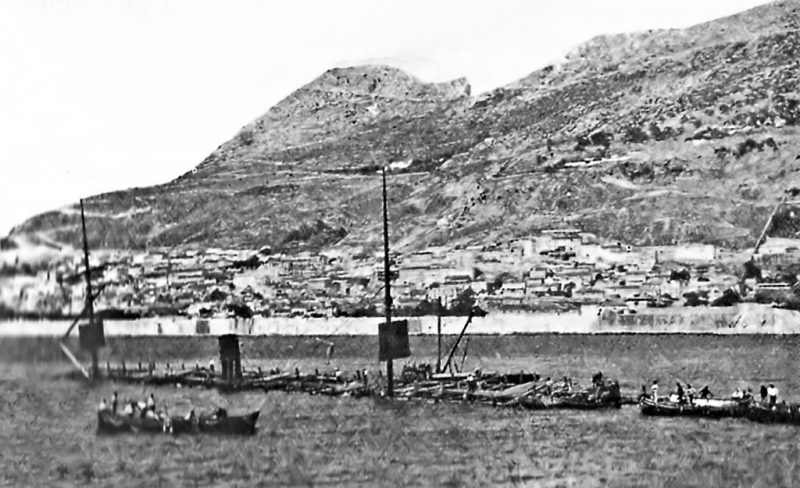
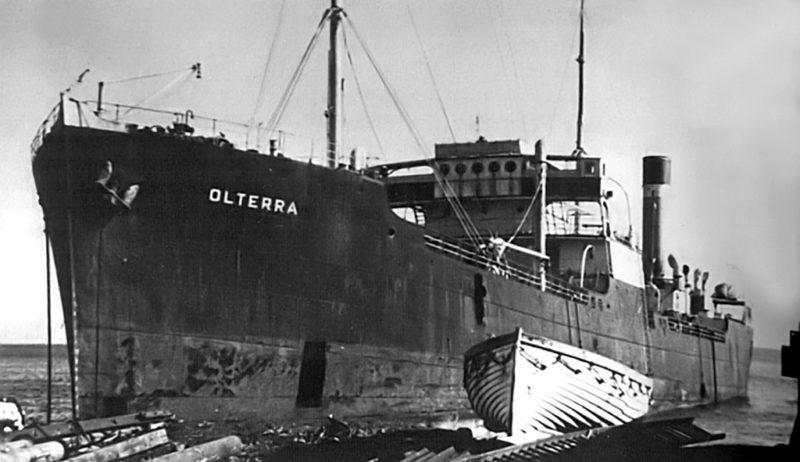
GIBRALTAR MARITIME DISASTERS
The bulker New Flame of 43,815 dwt collided with the tanker Torm Gertrud in August 2007 after apparently leaving the Port of Gibraltar without permission. She drifted aground to a position just east of Europa Point and close to shore, and became a tourist spectacle until she sank without trace around six months later.
The five hold bulker OS 35 collided on 29th August 2022 with the LNG carrier Adam LNG and was beached 700 metres off Catalan Bay with a gash measuring ten metres by four metres in the starboard side of her hull. OS 35 of 35,362 dwt with an overall length of 584 feet and a beam of 91 feet was built in Japan in 1995 by the Shin Kurushima yard as Golden Harvest. The forward three holds were flooded while the aft two holds and the engine room were afloat.
However, a loss of fuel oil from the engine room caused pollution on Catalan Bay beach and the beaches on La Linea. The casualty was stabilised by the Resolve Marine Group, which took over the Gibraltar tug operator TP Towage in 2015, and positioned the salvage tug Resolve Blizzard of 2,311grt and built in 1987 at Gibraltar to cover casualties in the Strait of Gibraltar. The Master of OS 35 was charged with seven offences relating to the casualty and oil pollution while his ship was manoeuvring to leave the eastern anchorage.
The 63,940 dwt bulk carrier Fedra was wrecked at Europa Point during a severe gale on 10th October 2008. The wreck broke in two.
The Anchor Line steamer Utopia of 2,781grt and built in 1874 by Robert Duncan & Company of Port Glasgow, inaugurated the London to New York service of Anchor Line, making a record forty round voyages on the route. She was transferred to the Glasgow and Mediterranean ports to New York run in 1882. She sailed from Naples on 3rd March 1891 for New York with 815 Italian emigrants (663 men, 85 women and 67 children), three better off Cabin Class passengers, and a crew of 59 with three stowaways, a total of 880 persons. On 17th March 1890 in pitch blackness, she entered Gibraltar Bay in a full south westerly gale and passed to the north of the South Mole, the only mole in existence at the time.
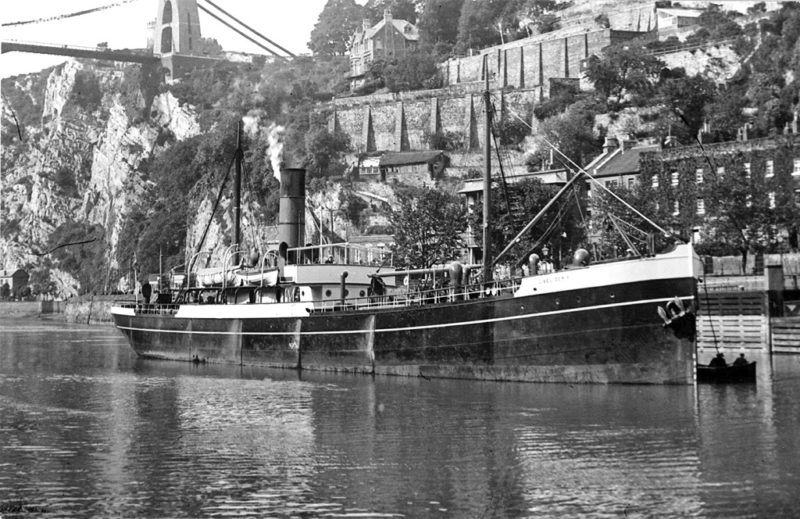

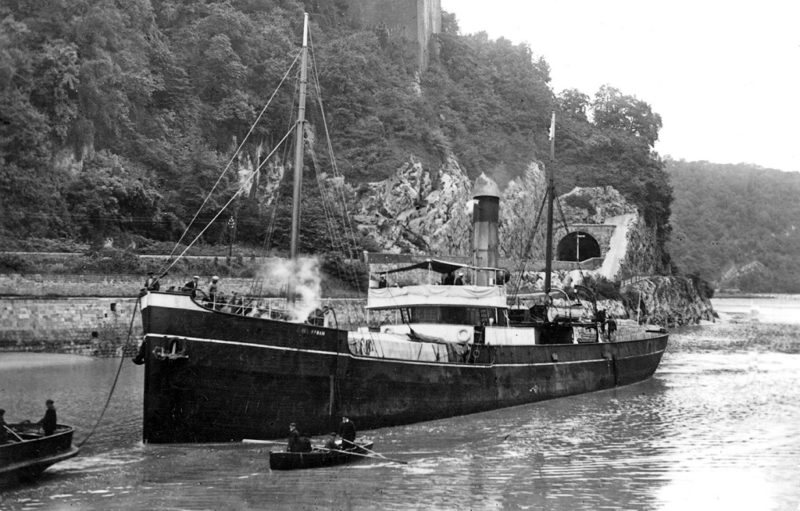
The British Channel Battle Fleet of six battleships was at anchor in the bay, with three more tied up on the inside of the South Mole, and Capt. J. Mackeagne passed too close to the ram bow of the battleship Anson, with the current and wind combining to punch a hole 27 feet by 15 feet in the stern quarter of Utopia. She began to sink by the stern and rested on the bottom of the bay with her upperworks, masts and funnel just showing above the surface of the bay in under thirty minutes. All lights had failed, and her passengers rushed towards the bow in a great panic to be saved but could only jump or be pushed to their deaths by drowning. The Fleet warships sent lifeboats and steam pinnaces to the scene of disaster but within ten minutes the tragic loss of 520 emigrants, one Cabin Class passenger, twelve crew members, and two naval rescuers had occurred, quickly perishing in the cold water. The cries of distress from the dying passengers could be plainly heard on shore, and many bodies that floated ashore were buried at North Front in mass graves with stone crosses and lists of their names at the bottom. Utopia was drawing 43 feet forward and 56 feet aft and was lying on the seabed with a list to port a danger to shipping and had to be removed.
Thomas Armit, a Scottish engineer, was given the job and constructed a cofferdam on shore, and using divers it was fixed to the damaged portion of the hull. The wreck was then pumped clear of water and came to the surface some 17 weeks after the disaster. She was patched up and towed to the Clyde by the tug Stormcock and laid up for nine years until she was sold in April 1900 for breaking.
The Master of Utopia met with severe conditions of winds and waves and the sight of six massive British battleships in front of him as he sailed on a parallel course to the South Mole towards its end. He had taken only enough coal onboard to get his vessel to Gibraltar, and thus took the shortest course amongst the battleships to get to his berth. The correct course of action, with hindsight, was to steam up to the north end of the bay and wait for daylight and the easing of gale force conditions.
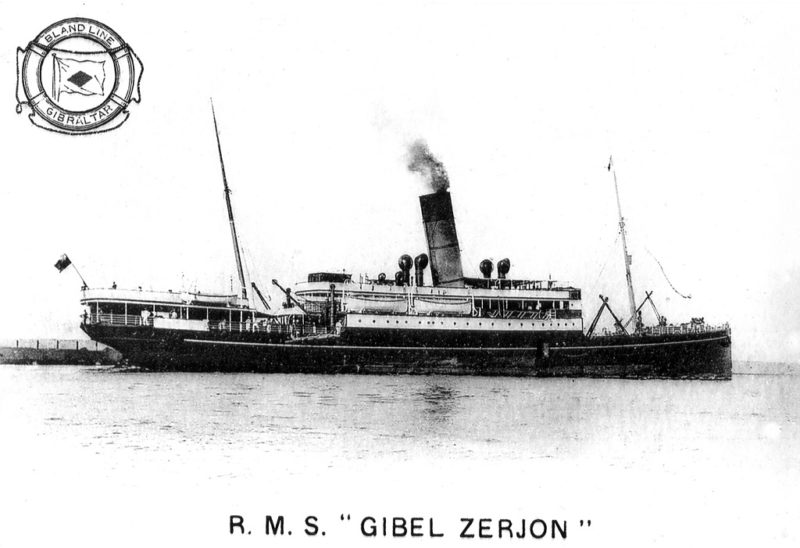
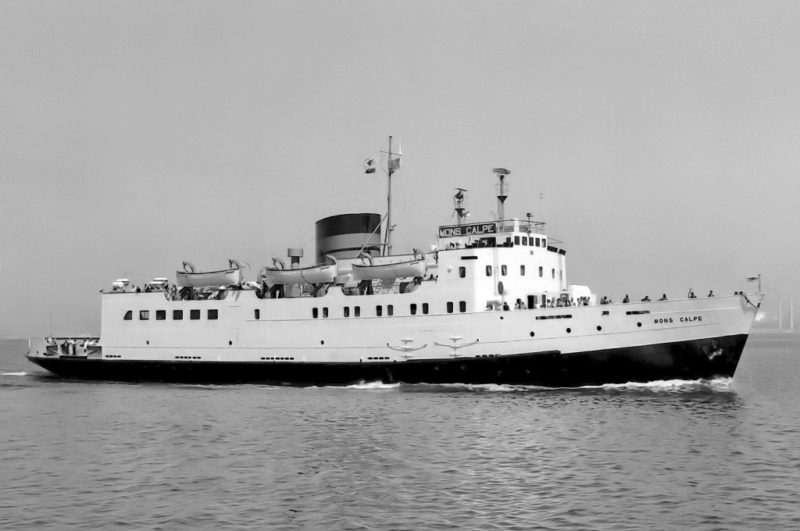
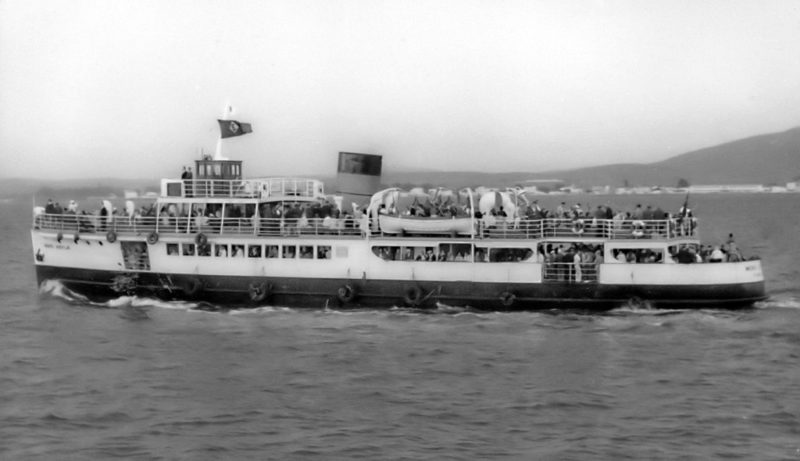
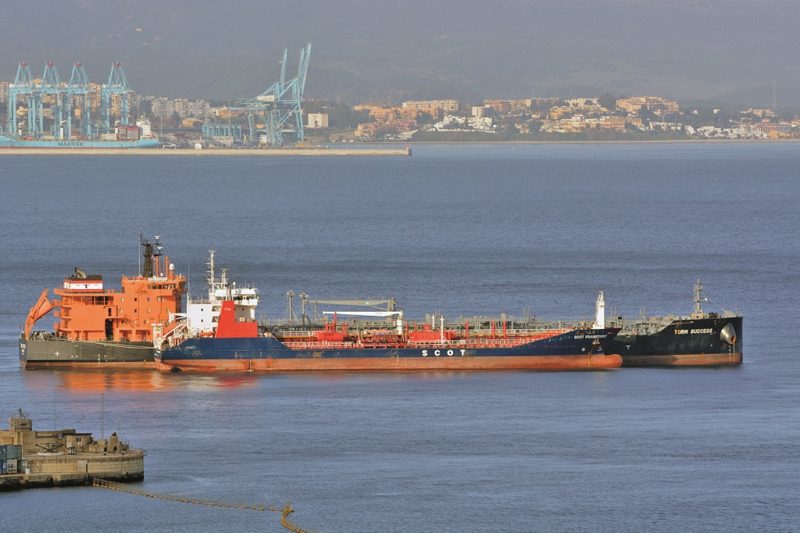
Many acts of bravery were recorded that terrible night with eight silver medals presented to rescuers by the Governor of Gibraltar, General Sir Lothian Nicholson, as rescuers sought to fire rocket powered lines to the wreck, but to no avail as the lines were blown back almost into their launchers. Bronze medals of the Board of Trade and from the Royal Humane Society and certificates were presented to all members of the Port Department who were on duty that night.
On 17th January 1933, a huge storm in the Bay of Gibraltar forced passengers from the black hulled liner Maloja of P. & O. to spend the night ashore after being landed by the tenders Cometa and Mary Claire of the company agents Smith, Imossi & Co. Ltd. Cometa was driven ashore on Western Beach together with three lighters.
The liner Ranpura of P. & O. dragged her anchors on 14th April 1936 and ran aground in a heavy gale on the sandy beach of Puente Mayorga near La Linea. She was refloated three days later after a huge amount of pulling by naval tugs and was undamaged.
The white hulled P. & O. liner Strathnaver had to anchor close in to Catalan Bay on the east side of Gibraltar in 1937, leaving 150 passengers stranded onshore.
The twin screw passenger tenders Cometa of 148 grt built in 1892 by J. P. Rennoldson & Sons of South Shields, and Mary Claire of 221 grt built in 1929 by Smith’s Dock Co. Ltd. at Middlesbrough gave long service in the Bay of Gibraltar. Mary Claire also transported service personnel on leave during the war from Naples to Capri for a number of years, before returning to her duties in the Bay of Gibraltar.
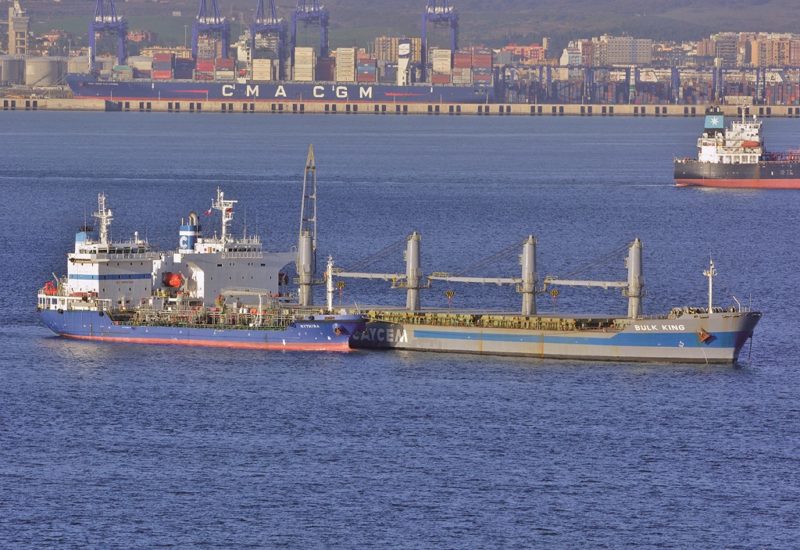
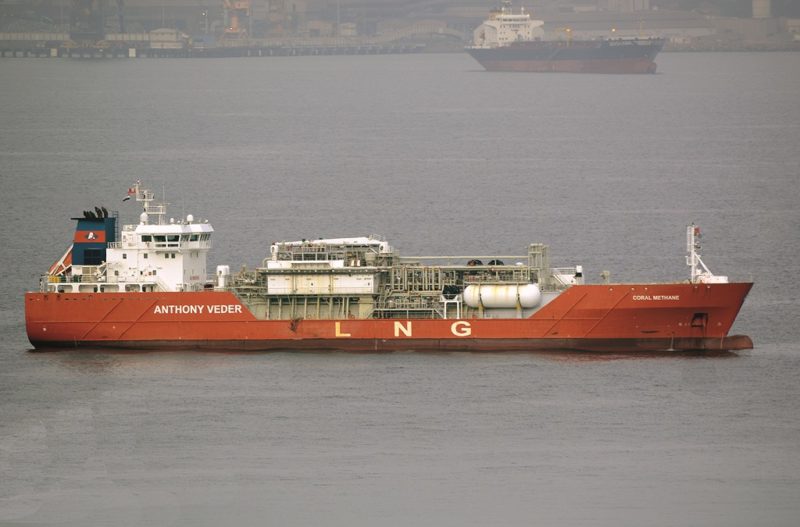
In World War II, the cargo-liner Durham of the Federal Steam Navigation Co. Ltd. fought back bravely against the enemy throughout 1940 while being mercilessly pounded on a dash to Malta, mined off Pantellaria on the return voyage, and then in the safety of Gibraltar harbour completely disabled by a limpet mine fixed by an Italian two man underwater chariot. She was out of action for a total of two years after being towed back to the U.K. for repairs, but survived it all to serve the company for 31 years. She was one of the Allied ships damaged or sunk by limpet mines during the period 24th September 1940 to 15th September 1942 of six attacks launched by Italian submarines or by combat swimmers on shipping at Gibraltar, resulting in the loss of ships of total tonnage of 40,000 grt.
The Italian tanker Olterra of 4,995 grt was responsible for harbouring Italian midget submarines that sank six Allied merchant ships in the Bay of Gibraltar. The midget submarines were launched through a hatch at the bottom of her forepeak while lying at the mole at Algeciras. The period from 8th December 1942 to 4th August 1943 was when the six Allied ships were lost together with two Allied seafarers. The British naval authorities never suspected Olterra was being used in this way and never found any proof of these attacks, even though her superstructure was clearly visible from the roof of the Gibraltar Royal Navy headquarters above the mole at Algeciras. Captured Italian frogmen told British security that they had been launched from Italian submarines.
Olterra had been built by the Palmers yard at Jarrow in 1913 for a German company, and was sold a year later to Standard Oil of New York. She was sold to the British Oil Shipping Co. Ltd. during the 1920s, and was then purchased by Andrea Zanchi of Genoa, and she arrived in Algeciras in 1940 and was then scuttled by her crew on 10th June 1940 after the entry of Italy into the war. Olterra was recovered in 1942 by a special unit of the Italian Decima Flottiglia MAS to be used as an undercover base for manned midget submarine attacks on Allied shipping anchored in the Bay of Gibraltar.
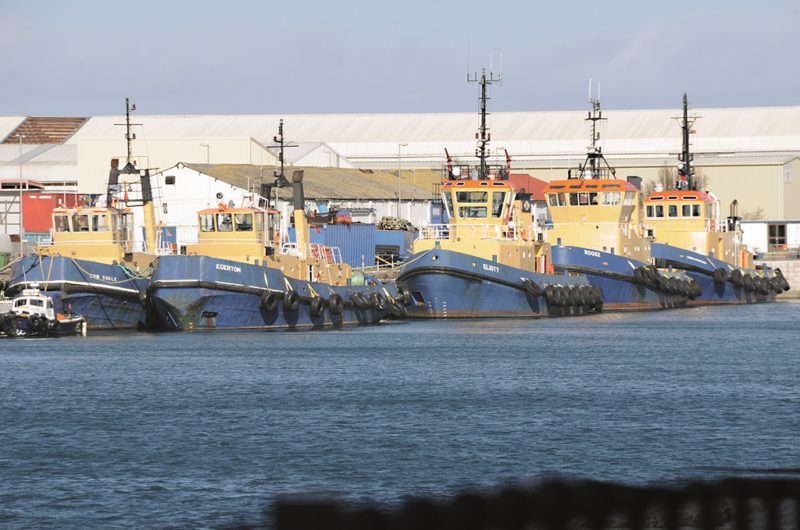
The six Allied ships sunk by the Olterra’s mini-submarines were:-
- ‘Liberty’ types Pat Harrison of 7,191grt and Harrison Gray Otis of 7,176grt
- Cargo-liner Mahsud of 7,126grt of Brocklebank Line. In 1945 she was refloated and repaired
- The tramp Camerata of 4,875grt owned by La Tunisienne Steam Nav. Co. Ltd. and managed by Strick Line
- Tanker Thorshovdi of 9,944grt owned by Thor Dahl A/S of Norway, broke in two and scrapped
- The tramp Stanridge of 5,975grt owned by Jack Billmeir
Olterra returned to commercial tanker trading after the war, and was broken up in 1961.
The British Government naval ammunition carrier Bedenham of 1,488 grt arrived in Gibraltar on 24th April 1951 with a cargo of 500 tons of ammunition to be discharged to the naval magazines at Ragged Staff Tunnel in H. M. Dockyard. She was berthed at Gun Wharf starboard side to quay facing east, and had onboard high explosives including depth charges, anti-submarine Hedgehog and Squid rockets, shells, bombs and small arms bullets. A small fire was started after a loud explosion was heard from a lighter alongside into which depth charges were being discharged just before 1000 hours with flames and dense smoke billowing up. It was clear a disaster was about to happen, and ten minutes later it did with an enormous ear-splitting explosion that sliced Bedenham into two almost unrecognisable parts of twisted metal.
Unfortunately, thirteen people were killed, with eleven crew killed on the Bedenham, or on the lighter or nearby, while two were Spanish vegetable sellers who were hit by flying debris while standing outside the Queens Hotel.
A fire appliance on its way to the ship was completely blown into obscurity and disappeared into the sea, and the torpedo store and the battery shed near the ship were unrecognisable from their former appearance. Large, heavy chunks of metal rained down from above with many more people injured. The after holds of the ship had sunk and mercifully the flooding prevented an even bigger disaster with an increase in loss of life. Bedenham had lost her bow section blown onto the quay, and it had crushed one of the big dockyard cranes beneath it, and only the stern part resembled what was a functioning ship before the explosion.
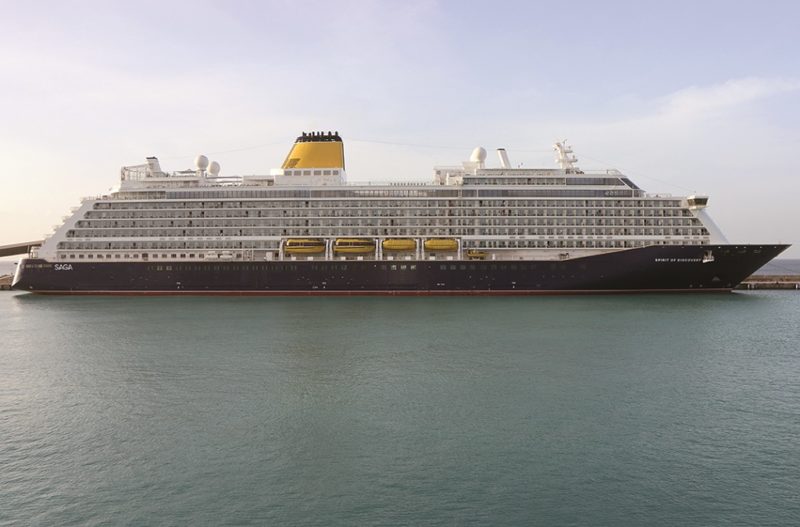
M.H. BLAND & COMPANY
The ship’s agents, coal trading, passenger ferry, passenger tender, salvage and travel agency businesses of the M. H. Group of Gibraltar were synonymous with the history of the Rock of Gibraltar. Marcus Henry Bland arrived in Gibraltar from Liverpool at the turn of the 19th century, and in 1810 he established a ship’s agency business trading from his house in Irish Town, the commercial part of Gibraltar at that time. In 1840, he went into partnership with Charles Middleton and John Mackintosh to grow the business, with the first ship to be purchased for Blands being the paddle tug Adelia in 1861 for service to Tangier. The sons of Marcus Henry Bland gained control of the company in the later 1860s after the death of their father in 1856, Charles Middleton (1860) and John Mackintosh (1865).
A fleet of lighters was acquired for cargo handling in the bay, and a small shipbuilding yard was set up to build lighters, tugs and launches. A coal base was established in 1869 soon after the opening of the Suez Canal and the need for coal supplies to ensure transits of the Mediterranean.
The first purpose-built passenger ferry was launched in 1884 at the Low Walker yard of Charles Mitchell on Tyneside as Gibel Tarik of 228 grt, and she served Blands for 48 years until broken up at Genoa in 1932. The sons of Marcus Henry Bland, Horatio and his brother John had died in 1891 without an heir, sold the company to Joseph Gaggero and his brother Emmanuel Gaggero for £28,474 in 1891.
Joseph Gaggero had worked for the Bland family as a clerk since the 1860s and knew the business well, with much coal bunkering carried out after the chartered colliers had brought coal from the British coalfields in the North East and South Wales. Gibel Derif brought cargoes of 1,300 tons of coal after her purchase in 1911 from British ports.
On 2nd August 1914, George Gaggero of age 17 years, was appointed Managing Director after the death of Emmanuel Gaggero and Avellano Gaggero during the previous year. World War I was declared two days after his appointment, and the heavy responsibility of management of the fleet of fifteen vessels was then shared by George Gaggero and his brother Charles Gaggero. Naturally, the loss of very many ships to enemy action during the war provided a boost for the Bland salvage business, and the company also lost two ships to enemy action in Gibel Yedid sunk by submarine off Ushant in 1917, and Gibel Hamam torpedoed off Abbotsbury near Chesil Beach in Dorset. The names were given to new purchased ships, with Gibel Yedid (2) being the former Ropner tramp Yearby of 2,639 grt, and Gibel Haman (2) being the former Southford of 1,338 grt. This Gibel Yedid was used extensively in the iron ore trade from Bilbao, Almeria, Sagunto and Huelva to the Tees and Rotterdam, as well as making a voyage from Huelva in 1921 with 4,500 tons of iron ore for Norfolk (Va) and returning via Baltimore. She was broken up at Rotterdam in 1931 after being sold off in 1925.
In 1920, the Bland Line fleet had grown considerably to ten passenger steamers named Gibel Derif (built as Svionia at Stettin in 1884 and purchased in 1920), Gibel Dersa built at Glasgow in 1878, Gibel Gelahui (ex Demetian built in 1900 and purchased in 1920), Gibel Habib built at Glasgow in 1900, Gibel Hamam (ex Southford built at Newcastle in 1899), Gibel Kebir built at Middlesbrough in 1887, Gibel Musa built at Port Glasgow in 1896, Gibel Sarsar (built in 1908 by Caird at Greenock as the twin funnelled passenger ship Isis for the P. & O. service from Brindisi to Port Said and purchased in 1920), Gibel Tarik built at Newcastle in 1894, Gibel Yedid (ex Yearby of Ropner built at Stockton in 1896), together with the salvage steamers Rescue, Express and Zweena, plus four tugs and three small passenger tenders. Regular sailings were made from Gibraltar to Tangier and Casablanca, as well as to Ceuta, Tetuan, Melilla, Alicante, Larache, Kenitra, Rabat, Mazagan, Saffi and Mogador. In 1921, two more steamers were purchased and renamed Gibel Zalag and Gibel Zerjon, and two years later the Thomas Haynes shipyard and foundry were taken over to provide new lighters and a diversification from the fleet of two dozen ships.

Trading was poor in the late 1920s, but a brave decision was made to purchase the twin screw steamer Duchess of Devonshire of 1,226grt from the London, Midland Scottish (LMS) Railway Company and rename her as Gibel Dersa. She was also capable of carrying a few cars to North Africa for the Bland Group, but the Depression that began with the collapse of the stock market at the New York Stock Exchange near the end of 1929 had a profound influence on the company. Bland Group was left with only four passenger steamers by the end of 1930 in Gibel Dersa, Gibel Habib, Gibel Kebir and Gibel Zerjon, together with two salvage ships, Rescue and Zweena, and six tugs.
The rise of the passenger services from Algeciras to North Africa for Spanish passengers using Compania Trasmediterranea ships from the early 1920s was another big factor.
In 1931, Gibraltar Airways was founded by Bland Group in another diversification for flights across the Strait of Gibraltar to Tangier using a Saro Windhover seaplane. A new Gibraltar registered M.H. Bland & Company was formed on 4th January 1932 to simplify its tax position, and the London company was wound up. The crushing Spanish Civil War from 1936 to 1939 had an adverse effect on the Bland passenger trades, and Gibel Zerjon was sold in 1939 and renamed Florida. Ironically, she started to sink in June 1940 near Cape Spartel at Tangier, and despite the best efforts and services of the Bland salvage steamer Rescue, she sank.
In September 1939, the Bland fleet stood at three passenger steamers, two salvage craft, and six tugs, but luckily none of this fleet was lost to enemy action during World War II. The Bland ship repair yard handled 2,267 vessels during the conflict.
George Gaggero was knighted in 1941 for services to Gibraltar, and in 1947 his son Joseph Gaggero aged 20 years joined the company.
Three ships were purchased in 1949, the salvage craft Hercules of 676 grt and built in 1942, and the dry cargo coaster Cornish Coast of 226 grt built in 1937 by the Ardrossan Dockyard was purchased from Coast Lines for the Casablanca trade and renamed Gibel Musa, and the former Townsend car ferry Forde of 829 grt, built at Port Glasgow in 1918, was purchased for the trade to Tangier and renamed Gibel Tarik.
A new side loading car ferry of 1,991grt and overall length of 270 feet to be named Mons Calpe was ordered from the Ailsa yard at Troon and arrived at Gibraltar on 31st August 1954 with accommodation for 586 passengers and space for 85 cars. New loading ramps at Gibraltar and Tangier were built for her use. She was urgently required as no service had been offered during the months from September 1953 across the Straits of Gibraltar when the previous car ferry Tarik had suffered serious mechanical problems and had to be withdrawn and was later broken up in 1954.
Mons Calpe had very good life saving equipment, and was of great economic and political importance to the influence of Gibraltar during her 32 years of service to Morocco. She was sold in 1986 to Red Star Line of Cyprus and renamed City of Limassol, becoming Igoumenitsa Express in 1987, and Lily T in 1988. She became Libyan owned in 1991 as Afrikia, and then sailed in 1992 to Mozambique for service from Maputo as Africa, where she sank on 12th September 1997 after a career of 43 years.
The Red Funnel Steamers Ltd. of Southampton motor ship Medina of 342grt and built by J.I. Thornycroft & Company at Southampton back in 1931 was purchased by Bland in 1962 and served for six years as a passenger tender. She was sold for use as a clubhouse at Lymington and then at Brighton.
I also remember seeing the white catamaran passenger vessel Mons Calpe II laid up at the North Mole in Millennium Year after only a brief resurrection of a jointly owned passenger service by the Bland Group from Gibraltar to Tangier. She was a catamaran with space for 180 passengers and had been built in 1975 for Norwegian owners as Sunnhordland. She was a financial failure and was sold off in 2001 to Split Tours of Croatia and renamed Brac.
A large number of European expatriates used to travel by Bland ferries to Tangier from Gibraltar, to one of the most exotic cities of the world. The city is a meeting place of Europe and North Africa on the seaward threshold of the Strait of Gibraltar. The city was a Spanish enclave until 1956, when it was ceded to newly created independent Morocco, but retained much of its Berber and Arab heritage.
Tangier has everything you might expect of it, from a magnificent Palace of the Sultan, a powerful hilltop fortress called the Casbah, a slightly dangerous bazaar where one needs to keep a wary eye open, as well as carpet sellers, snake charmers, camel herders and wandering minstrels, all usually dressed in colourful full length robes.
Shipowning by the Bland Group thus ceased in 1986, with the business divided between grandsons John Gaggero, who then ran the maritime and port related activities as well as the Gibraltar Cable Car under the original name of M.H. Bland & Co. Ltd., and Joseph Gaggero, who then ran the other businesses of the group.
Today, great grandson Joseph Gaggero is Chairman of the Bland Group with ship agency, stevedoring, supply craft and coach tours business, and he has more than enough inherited entrepreneurial flair to run a profitable company that competes at an international level for many years to come.
The busy, main passenger and car ferry routes to North Africa today run from Algeciras to Tangier and Ceuta, and from Malaga to Melilla and Almeria to Melilla, Nador, Al Hoceima, Ghazaouet and Oran.

SHIPPING TO BE SEEN AT GIBRALTAR
The types of shipping that call at ‘The Rock’ are very varied and large in numbers, as when I spent three holidays staying at the Rock Hotel between 2000 and 2005 with a fabulous view of the harbour and the Bay of Gibraltar.
In 2005, a huge number of 6,269 ships of 229 million gt called at Gibraltar with an overwhelming majority of 5,367 ships calling for bunkers, as well as 166 cruise ships, 13 cargo ships, 75 ships for repairs, and 648 vessels of other types such as small local passenger ferries and yachts.
OIL AND LNG BUNKERING
Gibraltar is the largest bunkering port in the Mediterranean with companies such as Vema Oil, Cepsa Bunkering, Gibunco and Turner Shipping and others controlling the delivery of over five million tonnes of bunkers supplied to most of the nine thousand ships that entered the Bay of Gibraltar in 2020. Busy bunkering tankers up to 10,000 dwt are used with names such as Cometa, Calpe, VB Veronica and Vemaoil followed by a digit, as well as double hull floating storage bunker tankers up to 100,000 dwt.
Bunkering is now the main activity within the Port of Gibraltar and continues to grow from strength to strength, and the main advantages of Gibraltar are:-
- Competitive market due to high turnover
- Low costs due to unique tax free status
- Competitive port dues and fast bunkering operations
- Located near to one of the busiest shipping lanes in the world
- Continuous monitoring by the Gibraltar Government to remain competitive
- LNG bunkering available since 2021 when Shell chartered LNG vessel Coral Methane supplied first LNG bunkers to the Sovcomflot Aframax tanker Lomonosov Prospect in March 2021
SUMMARY
The very distinctive outline of The Rock of Gibraltar can be seen from as far away as fifty miles south from the Mediterranean coast of Spain, and is very impressive as one drives the last mile along the coast road into La Linea.
The many bunkering tankers and barges continue to be the main economic activity of the Port of Gibraltar today. Second in importance to the economy of Gibraltar today are cruise ships and international tourism. The annual number of cruise ship passengers has risen from 210,800 in 2006 to 406,900 in 2022, bringing in £16.7 million to the local economy in 2022, while the annual number of international tourists arriving by foot, car, coach or aeroplane has risen almost incredibly from six million to eleven million during the same time period.
Gibraltar has many attractions including a semi-tropical climate, the beautiful Alameda Gardens with scented blossoms all the year round, and in Gibraltar Town the thrilling Gibraltar Cable Car and the delights of Main Street, the Moorish Castle (Tower of Homage), Apes Den (Barbary macaques and the only wild monkey population in the whole of Europe), Gibraltar Nature Reserve, Siege tunnels, Mediterranean Steps, John Mackintosh Hall, Gibraltar Museum, as well as the nearby Governor’s Residence, the Catholic Cathedral and the Anglican Cathedral.





Comments
Sorry, comments are closed for this item